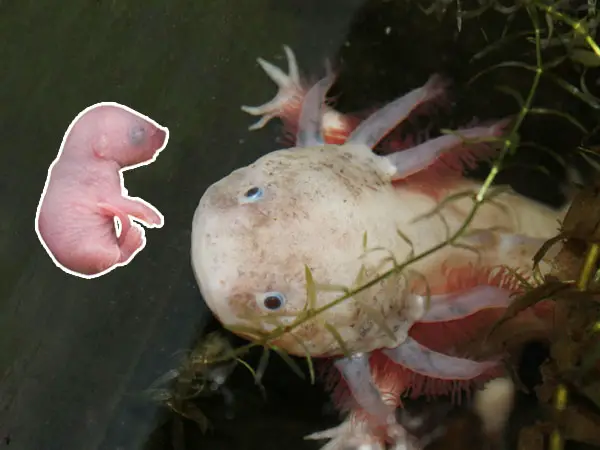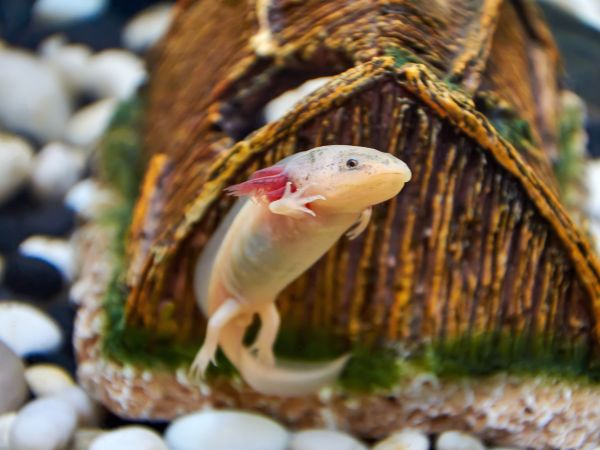One of the most intriguing things about axolotls is that you can’t really tell the gender of the axolotl that quickly. There are only small differences between the male and female axolotls. So you might want to observe them closely to distinguish them by sex.

But axolotls can’t change their gender. While some animals might be able to do that in their lifetime, it’s certainly not typical of axolotls. Axolotls have two genders, and they are very much set in stone – no changes are likely to happen to their genders, despite the fact that some amphibians might be able to change their gender.
So no, the total makeover is not possible. It’s only possible to see if you have male and female axolotls in your tank, which makes it possible for you to breed the axolotls if you want to, and distinguish them by gender.
Females are rounder and have some physical differences from the males – these subtle differences tell you the gender of the axolotl.
In this article, we’ll examine the genders of axolotls, and how you can distinguish them by their gender only by looking at their bodies.
How to Tell if Your Axolotl is Male or Female?
While male and female axolotls might look quite similar, there are some key differences that you should observe that will help you distinguish their genders.
Firstly, their body shapes are very different. Female axolotls may have much rounder bodies than male axolotls, which is because females are expected to carry eggs and that’s why their bodies have adapted to this fact. On the other hand, males have much longer and straighter bodies, so they look slimmer and slightly more elegant.
Also, males tend to have a longer tail than females, which is shown in the elongated shape of their body, but also their overall length is much greater. These are the main two differences that will tell you quickly whether your axolotl is male or female.
Also, you can easily distinguish male and female axolotls by looking at their cloaca (vent). The largest difference here is that male have a much more pronounced vent, because it is more swollen, so it will stand out more. Females only have a small bump in this position, if they even have a change in their body at all in this spot.
When Can You Sex Axolotls?
One of the biggest questions people who want to breed axolotls is when can I start breeding them?
You should be able to do so after around 6 months, when baby axolotls start growing up and they start to become fertile. And that’s also when they start to develop their ability to sex and start producing babies. Up to that point, axolotls will not have the ability to produce babies, so you won’t be able to sex them up to 6 months of age.
Before axolotls are 6 months old, you won’t be able to tell their gender for sure. Their bodies are still not fully developed at this point, and it might be difficult to tell exactly what gender the axolotl is.
But when they start developing their breeding organs and their bodies get prepared for breeding, they will start to distinguish themselves. Females will become rounder as they will become fertile and they will develop the ability to carry eggs. Males will become longer and they will have longer tails in order to attract females.
Do Female Axolotls Lay Eggs Without a Male?
No, that’s not possible.
Physical contact is needed to make your female axolotl pregnant, so they can’t start to develop eggs unless they have a male around them.
Can You Keep Two Male Axolotls Together?
Yes, you can easily keep two male axolotls together. You only need to make sure they are of a similar size and age, so they won’t intimidate each other and fight with each other.
You might have heard how some other species have males that often fight with each other. However, axolotls are normally peaceful in this regard, so they probably won’t fight with each other unless something very serious happens, or when they are provoked to do so.
And this can also happen if you don’t enable them the conditions to live normally. For example, if they don’t have enough space, they might start to fight each other to assert dominance in the tank.
You can even keep multiple males together as long as the conditions are right. The tank should be large enough for all of the males, and there should be enough food for all of the axies inside.
Alternatively, you can even keep multiple females together in the tank. Females are far less aggressive towards each other and are unlikely to cause unrest. So you can keep multiple of them together as long as you provide them with the right conditions.
Why are My Axolotls not Breeding?
This is possible that it will happen in your tank, sometimes even when you’ve considered all of the factors to enable breeding.
Some of the most common reasons why axolotls are not breeding include:
- You didn’t see them properly. That can happen if the male and female are not together, or when you fail to distinguish the genders of the axolotls in the tank.
- They are not old enough. That happens quite often. Impatient axolotl owners want to have quick results, so they want to start breeding early. But the truth is that it takes at least 6 months for the axolotls to grow before you can start breeding them effectively.
- Wrong water parameters. The water temperature is arguably the most important factor here. You must make sure that the temperature is set up correctly at all times, or the axolotls simply won’t breed.
Conclusion
In short, axolotls cannot change genders. They won’t do so in their lifetime, even if some other amphibians are capable of this.
You should be able to distinguish their genders before you breed them, though.




